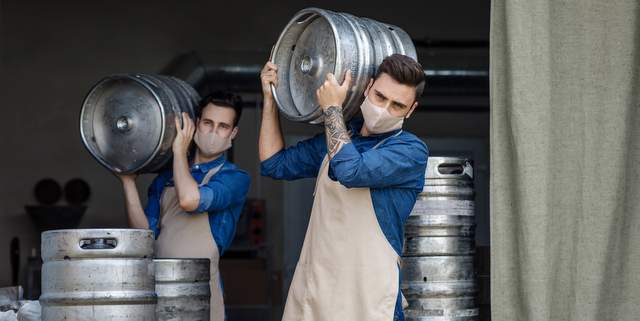
The Tax Cuts and Jobs Act (“TCJA” or the “Act”) was signed into law in late 2017, marking the largest change to U.S. tax policy in decades. One change in particular brought on by the TCJA will serve as one of the more advantageous tax savings opportunities for “small” breweries — the changes made to IRC §471 rules for inventory. The Act defines “small” breweries as those with less than $25 million of average gross receipts for a trailing three-year period. For breweries that have not been in business for three years, the average gross receipts of the years in operation are used. For discussion purposes, we are using breweries as the example, but many of the considerations of this article remain unchanged for brewpubs, distilleries,and other manufacturers.
Treatment of inventory pre-TCJA
Before we evaluate the inventory treatment change, we must first understand how inventory was treated prior to the Act being passed. An asset is a “resource owned by a company which has future economic value that can be measured and expressed as dollars”; inventory, in the case of breweries, is the most crucial asset in terms of operations. IRC §471 and a basic accounting principle known as the “matching” principle requires producers of inventory to capitalize raw materials, work-in-process (WIP), finished goods, associated labor and other subordinate costs, known as overhead. The reason inventory, labor and overhead costs must be capitalized is to “match” the expense(s) of producing (or acquiring) the inventory with the revenue received from selling the inventory. This concept was true for both financial and tax accounting, with potential minor adjustments in the tax realm.
Treatment of inventory post-TCJA
On August 3, 2018, the Internal Revenue Service (IRS) issued guidance to provide small businesses procedural guidance on accounting methods affected by the TCJA. Additionally, this guidance provides for “automatic consent” if a taxpayer changes their accounting method. By making the change automatic, breweries will not be required to request permission from the IRS or pay a fee to change its method.
One of these provisions permitted small businesses to avoid the application of IRC §471, as described above. Rather than capitalizing inventory costs when purchased and produced, small businesses are permitted to treat inventory as non-incidental material and supplies under the treasury regulations. These regulations clarify that non-incidental materials and supplies are deductible at the time they are “used or consumed,” rather than at the time they were purchased or when they are transferred or sold to the next user of the sales cycle.
In addition, breweries may elect a “de minimis” safe harbor exemption for raw materials which mirrors the de minimis safe harbor election that was introduced with the tangible property regulations.
What does this all mean for small breweries? Immediate expensing of hops, yeast, malted grains and other raw materials when purchased, subject to limitations, and an immediate write-off for currently capitalized WIP (think beers currently in the fermentation process, conditioning process, canning process, etc.) and finished goods inventory highlighted in a two-part process below.
Part one: de Minimis inventory purchases
Treasury regulations permit ALL taxpayers, not just small businesses, to immediately expense the cost of property used in a trade or business if the cost of the property does not exceed $2,500 per item. If the taxpayer has an “applicable financial statement” (AFS), that limitation is increased to $5,000 per item. The most common applicable financial statements for small businesses are financial statements audited by an independent CPA firm used for credit purposes, shareholder reporting or other substantial non-tax purpose.
Breweries that meet the definition of a small business are now eligible to immediately expense, via an annual election, raw material purchases under $2,500 per item, per invoice. There is a small caveat, however, in that the de Minimis election binds both financial and tax reporting, meaning that if breweries capitalize the qualifying de Minimis inventory for financial purposes, they are required to capitalize the inventory for tax purposes as well.
Why would we elect to not immediately expense the inventory for financial purposes? Typically, small businesses have covenants tied to long-term financing that can be negatively affected by a reduction of inventory. Additionally, excess losses from these changes may not be deductible by an individual taxpayer, but this must be assessed on a case-by-case basis.

Part two: Non-incidental materials and supplies
As mentioned previously, non-incidental materials and supplies can now be deducted at the time the materials are used or consumed. This change leads to the elimination of work-in-process and finished goods inventory for tax purposes. Unlike the de Minimis rule in step one, tax treatment of non-incidental materials and supplies does not have to follow the financial accounting treatment, which will require a book-tax adjustment on the brewery’s income tax return.
After following the first step, we now have two different “buckets” of non-incidentals materials and supplies; WIP and finished goods that were still in our inventory at December 31 of the prior year and current year WIP and finished goods stemming from the manufacturing or purchase of raw materials that could not be expensed under the de Minimis rule. In order to make the correct tax adjustments, the brewery must be able to identify which year the inventory is attributed.
It is also key to mention that if the taxpayer elects to treat certain inventory costs as non-incidental materials and supplies, direct labor and overhead costs associated with the production or acquisition of the inventory will be fully deductible as incurred.
Making the changes
Raw materials under the brewery’s de minimis safe harbor election threshold can be written off during the preparation of the tax return, but again note the change must be reflected on the financial statements as well.
The §471 inventory change must also be reported on Federal Form 3115 — Application for Change in Accounting Method under the automatic method change procedures. The company will have to identify which WIP and finished goods were present as of January 1st of the respective tax return year, and will report the amount, known as a 481(a) adjustment, as an additional expense item in Cost of Goods Sold.
Once this method change is elected, the cumulative increase or decrease in the amount of WIP and finished goods between two tax years will be recorded as a book-tax adjustment on the brewery’s income tax return.
Closing remarks
As mentioned before, this change to our tax system is the largest in decades and it is imperative breweries understand how they will be affected by the new guidance. The highlighted inventory adjustment has slipped through the proverbial crack due to a majority of the coverage of the Act revolving around individual income tax changes, the 20 percent flow-through deduction and the 100 percent accelerated bonus depreciation deduction. For breweries, this seemingly overshadowed change could result in large tax savings.
Tim O’Neill, CPA, is a tax supervisor and leader of food and beverage industry services at Mueller Prost CPAs + Business Advisors in St. Louis.





Leave a Reply
You must be logged in to post a comment.